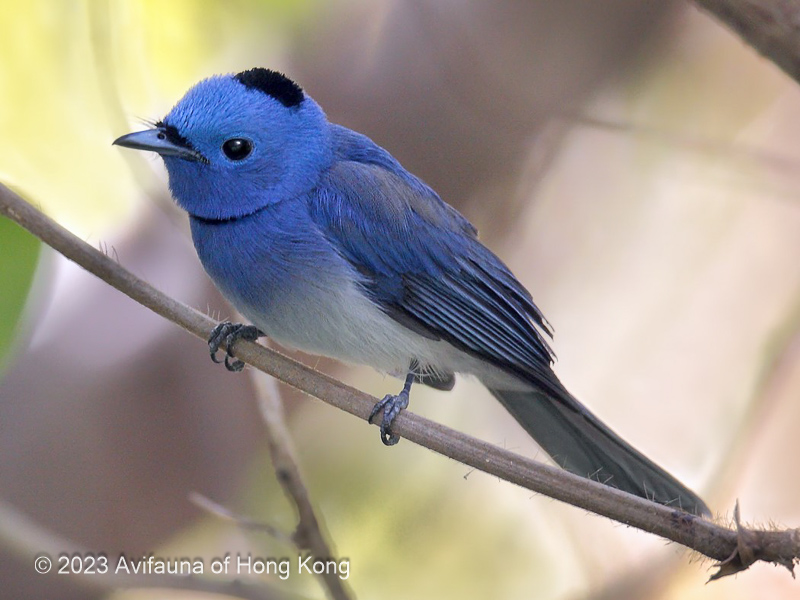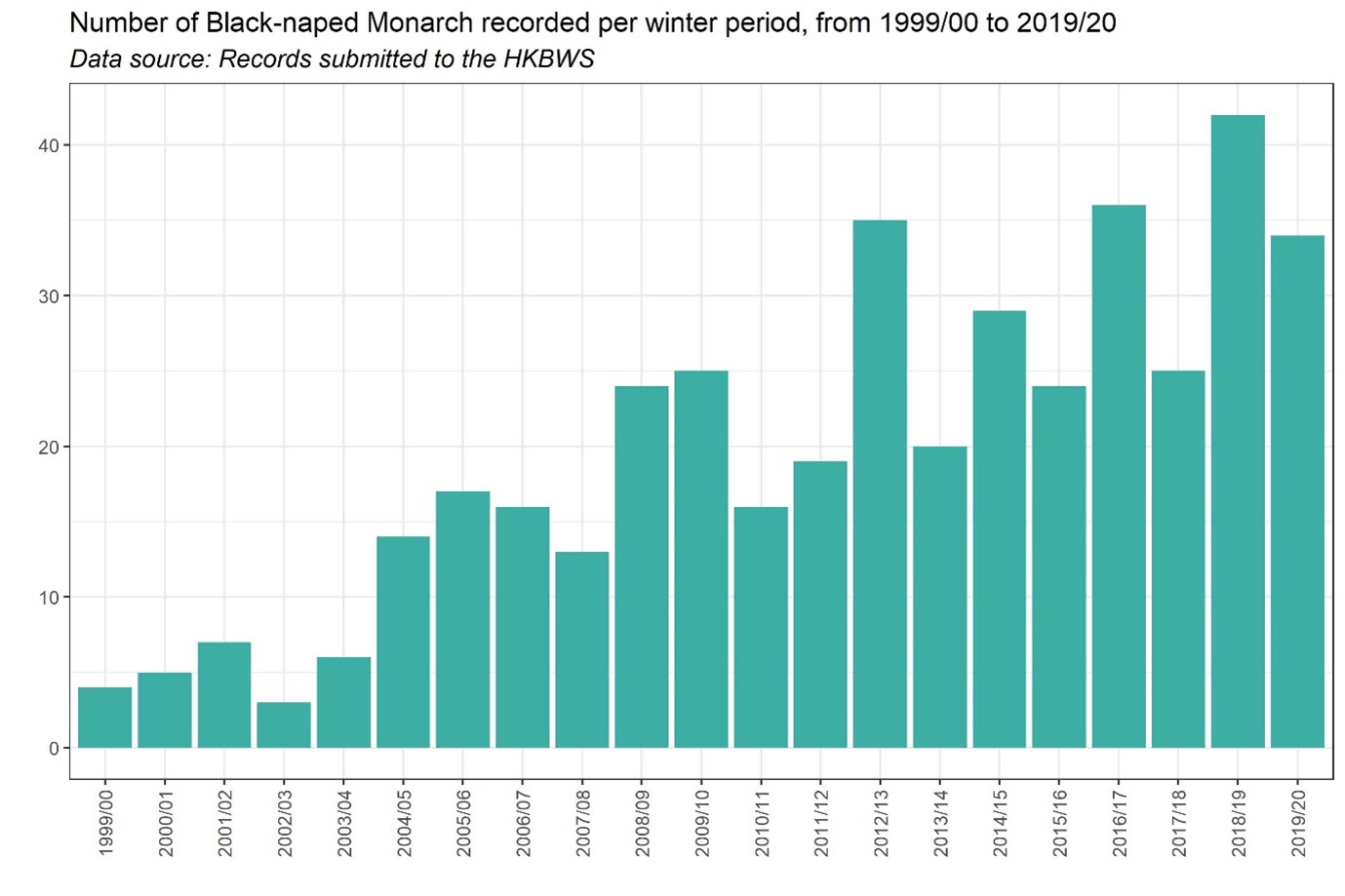Black-naped Monarch Hypothymis azurea 黑枕王鶲
Category I. Uncommon but increasing winter visitor and passage migrant to woodland and shrubland.
IDENTIFICATION

Jan. 2009, Michelle and Peter Wong.
15-17 cm. A small, bluish monarch-flycatcher with a whitish belly and longish tail. The male has a pale blue head, throat and breast, with a black nuchal tuft, black feathering at the base of the bill, and a black band across the upper breast. The mantle, wings and upper tail are a duller blue.

Oct. 2021, Michelle and Peter Wong.
The female has a duller blue-grey head, throat and breast; although it has black feathering at the base of the bill, it lacks the black nuchal tuft and breast band of the male. The mantle, wings and upper tail are brownish-grey; the belly is white.
VOCALISATIONS
The call is a somewhat harsh and explosive single or double-note, resembling Amur Paradise Flycatcher but harsher.
The song, occasionally heard in late spring, is a rapidly repeated ‘weet-weet-weet…’ or ‘whit-whit-whit…’.
DISTRIBUTION & HABITAT PREFERENCE
Widespread, occurs in woodland, shrubland, parks and gardens, sometimes in urban areas, with regular records from a number of sites in forested areas of the New Territories and offshore islands such as Po Toi, Lamma and Cheung Chau.
OCCURRENCE
Winter visitor and passage migrant to woodland and shrubland areas; extreme dates are 9 September and 5 May.
Numbers remain generally low during September and the first three weeks of October, but are highest from the last week of October to the end of the year. Peak numbers occur in November, suggesting that both passage and wintering birds are involved. Numbers during the second winter period tend to be lower, declining through March to mid-April, when both late-wintering birds and a few passage migrants occur. Rare after the second week of April (Figure 1).
It is usually seen singly, occasionally in pairs, with no more than three birds reported from the same area apart from four on Lamma Island on 31 December 2009. Some birds may remain in the same area for a considerable time, e.g., a female visited a garden in Palm Springs regularly from 6 November 2019 to 27 March 2020. In addition, what was presumably the same female was seen there the following winter, indicating that some individuals may return to the same site in consecutive years.
Numbers vary considerably from winter to winter, but there has been an obvious increase in total numbers recorded (Figure 2), though this is presumably largely, if not entirely, due to an increase in observer activity. Until 2003/04 the estimated number of individuals each winter period was in single digits, but since 2004/05 has been in double-digits, with a high of 42 in 2018/19.
Kershaw (1904) described it as common during winter at the mouth of the Pearl River. It was first reported in HK on 22 February 1956 (Walker 1958). Herklots (1967) considered it to be a rare winter visitor.
BEHAVIOUR, FORAGING & DIET
Active and restless, occasionally fanning its tail, it forages below the woodland canopy in search of insects. Mostly occurs singly, but occasionally two birds are present, and it readily joins mixed foraging flocks in forest.
SYSTEMATICS & RANGE
Occurs from India east to south China and south through southeast Asia, the Philippines, Borneo, and Indonesia as far east as the Lesser Sundas. H. a. styani occurs in much of India and Nepal east to Vietnam and southeast China. It is largely resident but there is some seasonal movement to south Myanmar and central, northeast and southeast Thailand (Moeliker et al. 2020). In China it breeds in Sichuan, Yunnan, Guizhou, Guangxi and north Guangdong; some overwinter in the breeding range, but many migrate south and east to Guangxi, Guangdong and HK (Liu and Chen 2020). Twenty-two other subspecies are also recognised, many of them island races.
CONSERVATION STATUS
IUCN: Least Concern. Population trend stable.
Figure 1.

Figure 2.

Herklots, G. A. C. (1967). Hong Kong Birds. South China Morning Post, Hong Kong. 2nd. ed.
Kershaw, J. C. (1904). List of Birds of the Quangtung Coast. China. Ibis 1904: 235-248.
Liu, Y. and Y. H. Chen (eds) (2020). The CNG Field Guide to the Birds of China (in Chinese). Hunan Science and Technology Publication House, Changsha.
Moeliker, K., D. A. Christie, and G. M. Kirwan (2020). Black-naped Monarch (Hypothymis azurea), version 1.0. In Birds of the World (J. del Hoyo, A. Elliott, J. Sargatal, D. A. Christie, and E. de Juana, Editors). Cornell Lab of Ornithology, Ithaca, NY, USA. https://doi.org/10.2173/bow.blnmon1.01
Walker, F. J. (1958). Field Observations on birds in the Colony of Hong Kong. Hong Kong Bird Watching Society, Hong Kong. (duplicated).

